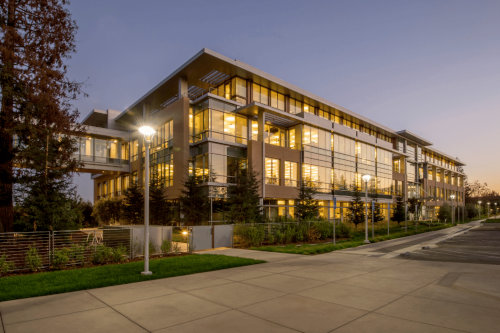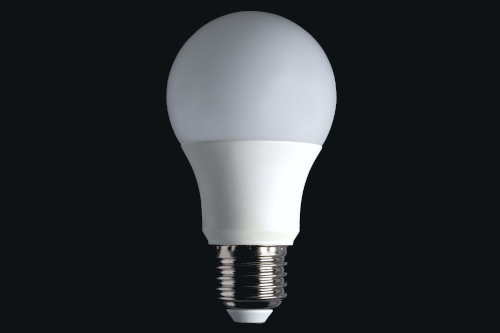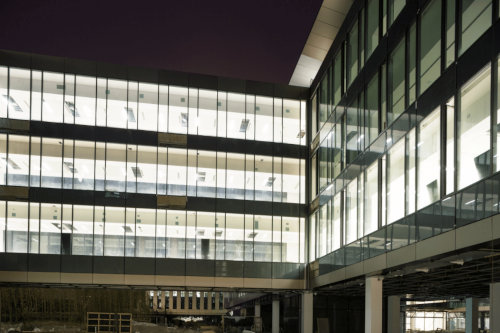Discover how smart lighting solutions improve energy efficiency, employee health & safety, and how they can save money compared to traditional lighting systems

Especially with the advent of LED lighting, commercial lighting has greatly improved in just the last few years. Along with the implementation of smart technology, lighting is now more intuitive, healthy, environmentally responsible, cheaper, and more customizable than ever before. That’s why today we are going to be taking a look at the history of smart lighting solutions, advantages of commercial lighting control systems, and smart lighting applications. Plus, we’re going to be going into detail about how renovating your commercial lighting can create a better and more sustainable workplace. Let’s get started!
The History of Smart Lighting Solutions
The smart lighting solutions we use today would not be possible without the technological advancements by Joel Sipra

With the invention of thyristors and dimming technology, inventors discovered the possibilities of what lighting could be.
Although smart commercial lighting is a hot topic these days when it comes to new construction and renovations, it is actually not a new concept. The first example of smart lighting can be traced back to the 1950s.
Joel Sipra was a nuclear physicist that discovered a device called a thyristor, which at the time was used as a part of a reliable trigger system for nuclear warheads. However, his discovery would persist long past the Cold War as the very same technology would also be used to create lightning variants.
Before this discovery, lights could either be switched on or off, nothing in between. These days we have become so used to the dimming option on our light switches that many assume this was always an option.
Once it was established that lights could do more than turn on and off, Joseph Spira began to test out different applications for his then-groundbreaking technology. At the time, the only dimming effect in use was for stage lighting using a device called a rheostat. This device was expensive and would turn light energy into heat energy to produce a dimming effect on the stage. When Joseph Spira invented the thyristor, he immediately identified everyday applications for his newfound dimming technology, whether it be on or off the stage. Additionally, the thyristor used far less electricity than the rheostat and the light bulbs lasted a lot longer. Since the thyristor was such a big improvement over the rheostat, the new technology quickly replaced the old.
The moment when Joseph Spira invented the thyristor would trigger an explosion in the lighting control industry. Once it was discovered that lights could be easily dimmed, inventors and the general public began to wonder if there were other ways to manipulate the light bulb. It is from this inventive spirit that modern-day lighting control systems and smart lighting solutions have come to be. With all of this information, now it’s time to discover modern-day lighting solutions and their benefits.
What Are Smart Lighting Solutions?
Before we begin talking about all of the advantages smart lighting solutions offer, we should first define what they are and how they work

Smart lighting improves how we exist & work in commercial buildings.
Smart lighting is extremely common these days, not just in commercial buildings but also in our homes. A smart lighting solution can range from a singular smart bulb or smart plug in your home to a large-scale lighting application connected to an IoT (Internet of Things). But, let’s not get ahead of ourselves, to put it simply, smart lighting refers to anything that provides light and can be controlled automatically.
When discussing commercial applications, there are a lot of ways that smart lighting can be integrated into any large space. For example, smart lighting is especially prevalent in sports stadiums. Not only do these smart lighting applications provide ample light for both the spectators and athletes—but there are also custom lighting packages that can create designs in the stadium lights, illuminate the outside of the stadium, and provide critical lighting infrastructure elements to guide guests & employees through indoor areas.
These smart lighting applications are not only powerful but they can also be controlled completely automatically via your building management system (BMS). That means that while there is a sporting event going on, there are whole sections of the stadium where the lighting is operating from a preprogrammed set of instructions instead of manual controls. The IoT and BMS work together to continuously monitor and adjust lighting based on both the program and an army of sensors around the building to ensure that the lighting is working properly and reporting when there is an error.
Because these lighting systems require far less human intervention, they are far more reliable. This reliability, in addition to the many other advantages, is what makes smart lighting solutions so popular for commercial installations.
Now that we have an idea of what smart lighting solutions are, it is time to do an in-depth exploration of why they have become an industry-standard in the last few decades.
Why are Commercial Operations Installing Smart Building Lighting Solutions?
Let’s find out why smart lighting solutions have taken over the commercial lighting industry

Smart lighting solutions can do much more than save energy.
There are so many reasons why businesses are installing smart commercial lighting in both their new builds and existing spaces. That’s why we’re taking an in-depth look at the three major reasons to go for smart lighting over traditional lighting:
- Energy Saving
- Superior Lighting Controls
- Increased Safety & Improved Quality of Life
Ready to get started? Let’s go!
Energy Saving
The biggest reason that so many companies are deciding to either build new properties with smart lighting or renovate their existing is to save energy. Lighting is second only to HVAC when it comes to energy consumption within any commercial building. Often, when a building is converted from traditional lighting to smart lighting, the operators can save up to 60% on their monthly energy consumption from lighting. This is a massive advantage for companies using smart lighting because it helps cut your operating costs.
Smart lighting solutions help businesses cut down on their lighting energy uses in one of two ways. The first way that they can decrease energy consumption is by using LED lights. LED lights not only consume far less energy than incandescent or fluorescent bulbs, but they are also able to communicate with your BMS via PoE (Power over Ethernet) technology.
Though we most commonly think of ethernet cables as a means of providing internet and phone connection, they are also able to carry electricity at low voltages. The development of PoE technology has led to some impressive automated lighting capabilities that have only been available for the last few decades.
But, how does communication via PoE help cut energy consumption? When your lights can receive information from your BMS system, that means they can respond to light and movement sensors. These sensors can then relay information directly to your lights. In practice, this means that no one will ever have to turn a light on or off in a building fully equipped with PoE smart lighting solutions. For example, if someone in your business has a habit of leaving their office lights on overnight—that means that precious energy is wasted lighting an empty room for 12+ hours. When you install PoE smart lights and motion sensors in your building, the lights turn off as soon as the room is unoccupied and no energy is wasted.
Energy-saving is not just about the bottom line either—it is also about keeping your building environmentally sustainable. Studies have shown that potential employees pay attention to building sustainability concerning certifications like those from LEED. LEED certification means that your building has been certified by a third party and has met a global standard for sustainability. These are awarded for design elements, construction practices, and operations for high-performance green buildings.
Superior Lighting Controls
In addition to the energy-saving capabilities of smart lighting solutions, they also provide superior lighting controls for large-scale commercial applications. Smart lighting applications can be easily controlled and altered from your BMS communicating via the IoT. That means that every aspect of your interior and exterior can be closely controlled. Just by accessing your BMS and either scheduling lighting commands or altering the lights in real-time, you can control the color, hue, and brightness of each individual LED light on your entire property. Without the use of LED and PoE lighting, this is an impossible task.
Lighting affects every aspect of our lives, so you should be able to easily change the indoor or outdoor lighting profile for your commercial space. This is especially true for buildings that serve different purposes. For example, your property might be a museum that relies on clear and bright lighting so your guests can see all exhibits on display. That’s great! But, what if you also host weddings and other special events. Those are going to require a vastly different lighting profile than the kind of lighting used in museums. Without a smart lighting system, putting on a special event would require bringing in a completely different lighting system, which adds yet another major cost to the event. On the other hand, if your property is equipped with smart lighting solutions via PoE, you’ll be able to easily and instantly adjust the lighting for any event. The ability to quickly and easily create distinct lighting profiles that can differ from day to day was previously unheard of. But, thanks to smart lighting, custom lighting profiles are becoming commonplace in large commercial buildings.
Increased Safety & Improved Quality of Life
Though the majority of commercial building owners will opt for smart lighting solutions because of the previous two reasons, there is one more reason to install smart lighting in a new or existing building—safety & quality of life. You might be wondering, how exactly can lighting improve safety and quality of life? Well, you’re in the right place to find out!
A smart lighting system creates safer working environments by providing employees with the ideal amount of lighting to do their job and safely navigate the building. When you use a PoE lighting system for your commercial space, you can ensure that every part of the building is properly lit so every employee can do their job to the best of their ability. If you have been relying on outdated lighting methods like incandescent or fluorescent bulbs, then it is very possible that the current interior lighting in the building is less than ideal.
When you install LED lights that communicate via PoE with light and occupancy sensors in the building, the system will automatically make sure that every room is receiving ample lighting. When you rely on outdated lighting methods, often these lights will go out or begin flickering without any notification. Too often these areas of insufficient lighting are not addressed quickly enough and can lead to work-related mistakes, eye strain, fatigue, or even work-related injuries.
With a smart lighting system installed, lighting sensors will ensure that lighting remains consistent throughout the day, no matter what. If there are changes in the weather, sensors can automatically adjust the lighting based on the amount of natural light coming into a workspace. If a light needs to be replaced, your light sensors will notice and cause the lights around the area to immediately adjust. Not only that, but your smart lighting system can also notify you via your BMS which lights need to be replaced.
Another major safety-related advantage of installing a smart lighting system is building security. When you use PoE to power your lighting system, you can also use it to power your security system including motion sensors, cameras, and floodlights. These three elements connected to your centrally controlled BMS can sense a potential intruder and then automatically turn on cameras and lights. This helps create a greater sense of security for anyone who enters your building regularly.
Now that we’ve talked about how smart commercial lighting applications using PoE for automation improve safety & security, it is time to talk about the quality of life a little bit more broadly.
Whether we realize it or not, lighting affects everything we do. Our bodies respond to lighting in ways that are imperceptible to us, yet can affect both our physical and mental health. If we are experiencing light that is out of sync with the current circadian rhythm, we will end up feeling fatigued and have more difficulty falling asleep. When you aren’t getting enough sleep, it affects everything you do and can lead to further health complications including metabolic disorders, mood disorders, and a compromised immune system.
It goes without saying that fluorescent and incandescent lighting are poor substitutes for natural light, but many people don’t quite realize how much these artificial and inefficient lighting methods affect our health. In a 2008 study, it was reported that there are severe health issues that may be caused by prolonged exposure to fluorescent lighting. A few of the disorders named in the study include ADHD, anxiety, and frequent migraines. Not to mention, anyone who has worked under fluorescent lighting for an extended period can attest to the stress caused by prolonged exposure.
When you opt to replace an old lighting system with a new automated smart lighting system, you are choosing to prioritize both the health and safety of everyone who enters the building.
How Are Building Owners Implementing Smart Lighting?
It doesn’t matter if you are building something new or retrofitting an old system, smart lighting is worth the investment

Business owners can either build new or renovate existing lighting methods.
If you are a business owner or a developer interested in building a new property, your new project will likely be designed with smart lighting in mind. But, if you are interested in retrofitting an older building, the process is a bit more complicated. First, it is important to connect your lighting to your BMS, otherwise, you’ll be missing out on highly valuable learning capabilities that can help you save time and energy. It is also important to consider that older buildings may require further updates to access some of the features we’ve just listed. For example, if you want to get the most from your smart lighting solutions, you also need to install sensors and PoE-compatible security cameras at a minimum. Though these older building renovations can get expensive, it is important to keep in mind that it is often more expensive to keep the old technology running properly than it is to replace it.
We hope you learned something about smart lighting solutions by reading about all of the different advantages accessible with a new installation. When thyristor was invented in the 1950s, it opened the world up to all of the intricate and frankly impressive lighting applications we take for granted today. If you are interested in updating or replacing your current lighting management system, LED lighting via PoE is the way to go. Not only do LEDs allow for virtually infinite customization abilities, but they also will save you the most on overall lighting costs. So, what are you waiting for? The time to replace your outdated lighting setup is right now. Trust us, the environment, your employees, and your bottom line will thank you.